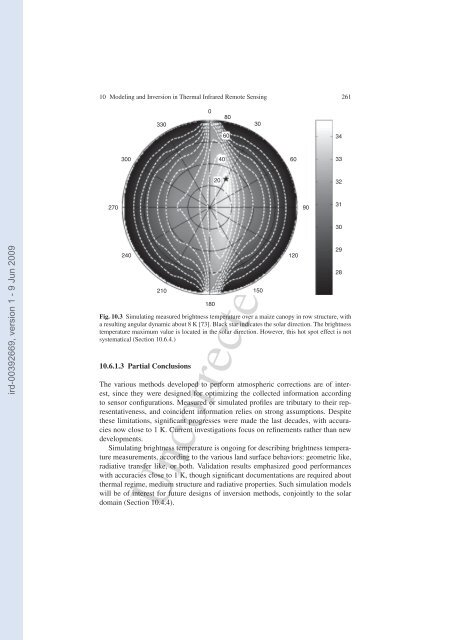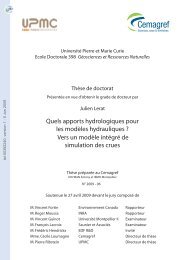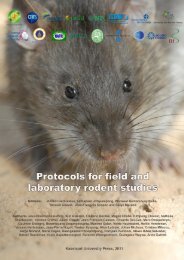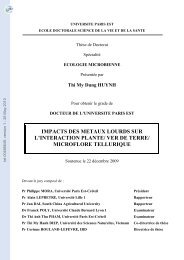260 F. Jacob et al.ird-00392669, version 1 - 9 Jun 2009content as a polynomial of MODIS near <strong>in</strong>frared radiance ratios, with a 0.4 g. cm −2accuracy. Atmospheric sounders allow <strong>in</strong>ferr<strong>in</strong>g profiles of temperature <strong>and</strong> watervapor density, us<strong>in</strong>g Eq. 10.6 or neural networks [3, 4]. Previous sounders such asTOVS permitted to reach a 0.4 g. cm −2 accuracy on water vapor content [200]. Newsounders such as IASI [201], with f<strong>in</strong>er spectral sampl<strong>in</strong>gs <strong>and</strong> spatial resolutions,should provide accuracies better than 1 K <strong>and</strong> 10% for atmospheric profiles of temperature<strong>and</strong> humidity.10.6.1.2 L<strong>and</strong> Surface Radiative Regime <strong>and</strong> Related MeasurementsSurface brightness temperature is simulated us<strong>in</strong>g simple radiative transfer equationsor simulation models. The former provide easy <strong>and</strong> efficient solutions for assimilat<strong>in</strong>gTIR remote sens<strong>in</strong>g data <strong>in</strong>to l<strong>and</strong> process models. The latter are f<strong>in</strong>e <strong>and</strong>accurate solutions for underst<strong>and</strong><strong>in</strong>g well TIR remotely sensed measurements.To constra<strong>in</strong> l<strong>and</strong> process model parameters, surface brightness temperature canbe simulated us<strong>in</strong>g simple radiative transfer equations coupled with SVAT models.[39] coupled the composite surface radiative transfer equation (Eq. 10.7) witha crop <strong>and</strong> a one source SVAT model. The latter calculated ensemble radiometrictemperature by clos<strong>in</strong>g surface energy budget. R-emissivity was estimated us<strong>in</strong>gthe SAIL TIR version of [136], documented by the crop model for vegetationstructural parameters. Similarly, [67] coupled the soil <strong>and</strong> vegetation radiative transferequation (Eq. 10.10) with a two source SVAT model. The latter calculated soil<strong>and</strong> vegetation temperatures by clos<strong>in</strong>g energy budget for each, while sett<strong>in</strong>g soil<strong>and</strong> vegetation emissivities to nom<strong>in</strong>al values.Calculat<strong>in</strong>g surface brightness temperature from simulation models requires <strong>in</strong>formationabout vegetation structure (row crop, LAI, LIDF, c<strong>over</strong> fraction), soil<strong>and</strong> vegetation radiative properties (emissivity, reflectance), <strong>and</strong> thermal regime(canopy temperature distribution). The latter can be derived from a SVAT model,which solves local energy budget accord<strong>in</strong>g to meteorological conditions (solarposition, w<strong>in</strong>d speed, air temperature), vegetation status (leaf stomatal resistance),<strong>and</strong> soil moisture. Then, simulation models mimic the radiative regime us<strong>in</strong>g moreor less complex descriptions of the thermal regime: a unique vegetation temperature[73], soil <strong>and</strong> vegetation temperatures with optional sunlit <strong>and</strong> shaded components[74, 137], additional vegetation layer temperatures for specific crops [145], orcanopy temperature profile [78].Simulation models are currently under development, verification <strong>and</strong> analysis[73, 74, 76, 78, 144, 145]. Current <strong>in</strong>vestigations focus on spectral behaviors [120],but especially on directional effects which allow normaliz<strong>in</strong>g multiangular observations(Fig. 10.3). For <strong>in</strong>stance, [58, 72] angularly normalized water stress <strong>in</strong>dices<strong>over</strong> row structured crops. Similarly, [202] normalized across track observationsfrom sun-view geometry effects, for a daily monitor<strong>in</strong>g at the cont<strong>in</strong>ental scale.Uncorrected Proof
10 <strong>Model<strong>in</strong>g</strong> <strong>and</strong> <strong>Inversion</strong> <strong>in</strong> <strong>Thermal</strong> <strong>Infrared</strong> <strong>Remote</strong> Sens<strong>in</strong>g 261ird-00392669, version 1 - 9 Jun 2009270300240330210018020408060Fig. 10.3 Simulat<strong>in</strong>g measured brightness temperature <strong>over</strong> a maize canopy <strong>in</strong> row structure, witha result<strong>in</strong>g angular dynamic about 8 K [73]. Black star <strong>in</strong>dicates the solar direction. The brightnesstemperature maximum value is located <strong>in</strong> the solar direction. However, this hot spot effect is notsystematical (Section 10.6.4.)10.6.1.3 Partial ConclusionsThe various methods developed to perform atmospheric corrections are of <strong>in</strong>terest,s<strong>in</strong>ce they were designed for optimiz<strong>in</strong>g the collected <strong>in</strong>formation accord<strong>in</strong>gto sensor configurations. Measured or simulated profiles are tributary to their representativeness,<strong>and</strong> co<strong>in</strong>cident <strong>in</strong>formation relies on strong assumptions. Despitethese limitations, significant progresses were made the last decades, with accuraciesnow close to 1 K. Current <strong>in</strong>vestigations focus on ref<strong>in</strong>ements rather than newdevelopments.Simulat<strong>in</strong>g brightness temperature is ongo<strong>in</strong>g for describ<strong>in</strong>g brightness temperaturemeasurements, accord<strong>in</strong>g to the various l<strong>and</strong> surface behaviors: geometric like,radiative transfer like, or both. Validation results emphasized good performanceswith accuracies close to 1 K, though significant documentations are required aboutthermal regime, medium structure <strong>and</strong> radiative properties. Such simulation modelswill be of <strong>in</strong>terest for future designs of <strong>in</strong>version methods, conjo<strong>in</strong>tly to the solardoma<strong>in</strong> (Section 10.4.4).150120Uncorrected Proof30609034333231302928
















